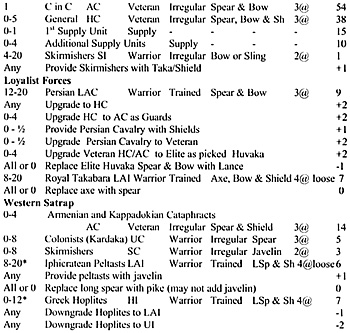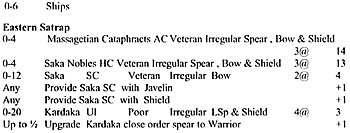Despite the scope and swiftness of the Persian ascendancy, one must not lose sight of the clannishness characterizing Achaemenid rule. At it's roots, this was based on the close cooperation of no more than ten family-based tribes (clans). That cracks would develop in this façade of unity is not surprising, and the last century of the empire would see recurrent civil war and satrapal rebellion. We are fortunate in that one of the best extant Greek sources is Xenophon's account of the trials and tribulations of Cyrus the Younger, who died fighting King Artaxerxes Memnon in 405.
The themes running through this list include the final “arrival” of the Persian cavalry as a formidable fighting force, the “disappearance” of the Amrtaka, and the decline of independent national contingents from the army, including the Medes, Lydians, Egyptians, etc. These subject armies had been phased out as part of Persian security policy, to be replaced in the national army by mercenaries. Indeed, it was largely in response to the internal crises faced by the Achaemenid government during this period that that policy came into being.
For the purposes of this list, the formalism of the neat divisions of the army into baivarabam has been dropped; presumably, the national army was repeatedly fractured by divided loyalties to competing factions. Persian armies of this period, raised in competition for the kingship or satrapal independence, were smallish and highly mobile. Three army variants of approximately 60 stands each are available from this list: (i.) a “loyalist” army, representing forces loyal to an Achaemenid king or heir, any several of which could be warring against each other at the same time (ii.) a western satrap, utililizing the best military assets available in Anatolia and Ionia, and Greece, to cast off the Persian yoke, and (iii.) an eastern satrap, using the best eastern Persian, Baktrian, etc assets to do the same.
Using this list, players may use any of the command and supply options from the common pool at the beginning of the list, then the rest of the stands must be chosen from one of the three sublists: loyalist, western or eastern.
Army List
60 Stands/30,000


More Achaemenid Persians
-
Introduction
A Persian Primer
A Great Power Emerges 550 - 500BC
Attack on the West 500 - 400BC
Civil War 400-338BC
The End 338-329BC
Sparabara House Rule
Back to Saga #81 Table of Contents
Back to Saga List of Issues
Back to MagWeb Master Magazine List
© Copyright 2001 by Terry Gore
This article appears in MagWeb (Magazine Web) on the Internet World Wide Web. Other military history articles and gaming articles are available at http://www.magweb.com